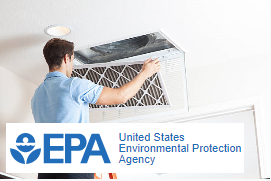There are a number of U.S agencies with the primary aim of protecting citizen’s health and wellbeing. Some of these regulations and rules are related to indoor air quality and are overseen by the EPA directly. So, here is a brief look at the impact the EPA has on indoor air quality.
The EPA Basics:
The EPA or Environmental Protection Agency was established in 1970 by the U.S Congress and President Richard Nixon. It was formed to oversee regulation of land, water, air and hazardous waste. Their main goal is to keep the environment safe and clean. The EPA creates regulations and rules to ensure the environment is protected, acting with oversight to ensure that businesses, organizations, and individuals adhere to protection laws.
How the EPA Benefits Homeowners:
While may of the EPA activities are related to manufacturing regulations, corporate pollution and developing safe production methods for foods, water, and oil, the EPA also has a vital role in keeping your home safe.
The main area where the EPA may have a direct impact on your home is the Energy Star program. This program was started and continues to be overseen by the EPA, and it was designed to help consumers to purchase HVAC systems and appliances that will use the least amount of energy possible.
The EPA also oversees the minimum requirements and measurements for home ventilation and insulation, which has a direct impact on your indoor air quality.
The EPA and Your Indoor Air Quality:
The current EPA regulations for indoor air quality are based on the low rise buildings ASHRAE Standards. These standards have been revised over the last two decades so that proper insulation and ventilation are maintained, and energy waste is reduced. The EPA also implemented the Clean Air Act, which has had a massive impact on how hoes should be ventilated and maintained.
The EPA also conducts a great deal of public service work to ensure the public is educated on the best ways to stay safe inside their homes. For example, the EPA has conducted campaigns on getting homeowners to test for radon, which is a potentially life threatening type of gas that can exist in any age of home.
The EPA also has one of the best resources online for tips and guidance to improve your indoor air quality. The EPA official website features indoor air quality pages that contain information about the current regulations and laws that impact your home. This can be particularly helpful if you are planning a remodel or addition to your home. There are also numerous resources for air quality testing and help to understand the pollutant levels inside your home.
Indoor air quality can have a massive impact on your health and wellbeing. In addition to having an effect on allergy symptoms and asthma, poor air has also been linked to a number of health issues. For this reason, the EPA is working hard to ensure that we all stay safe and enjoy good quality indoor air in our homes.
